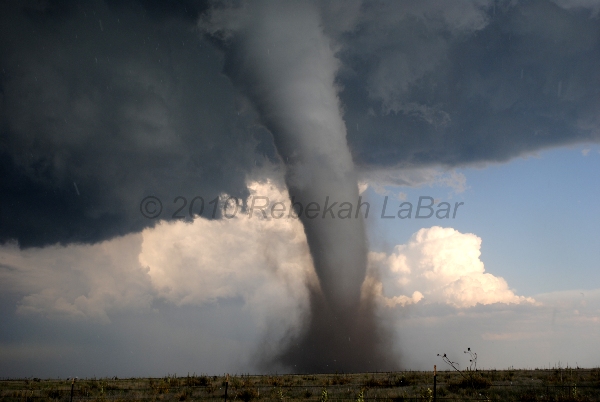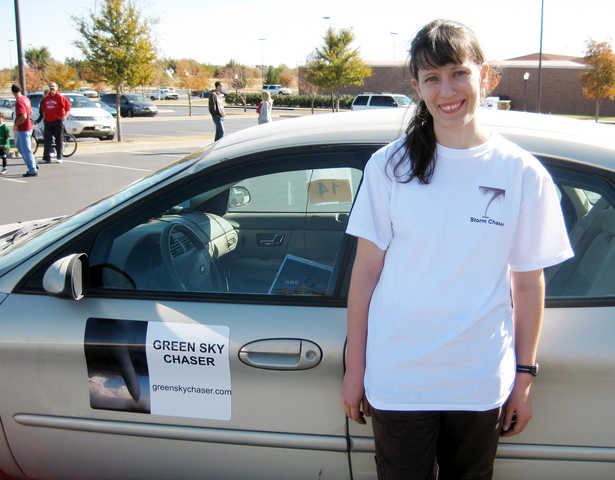02.10.11
Posted in Uncategorized at 8:00 am by Rebekah
The long-range GFS model is hinting at a pattern change that could soon bring spring-like temperatures and higher dewpoints to the Southern Plains. The wishcasting GFS model (i.e., so long-range that it can change every run and is virtually meaningless) is hinting that I could be chasing storms in Texas by the end of the month.
With the storm season just around the corner, I’ve been in a mad rush to get everything ready. I finished my 2010 chase logs and posting of photos on the website (I may post some video clips later, but all the best video is on the DVD anyway). I am finally starting to finish up posting chase logs and photos from 2007 and prior years (March 28 is up now, including photos of a beautiful, long-lived Texas Panhandle tornado). I only have 9 more of these old chase logs to post, and I plan to finish up within the next couple of weeks. I’m planning on getting some more practice soon with settings on my DSLR and HD camcorder, so I can take better photos and videos this year. I’ve already looked into a couple of equipment upgrades for this year, including data cards and mobile phone antennae, but I may just go with the setup I’ve got.

March 28, 2007, Briscoe County, Texas
In the meantime, I’ve also been busy with my paying job, which has had me programming in Perl and VBA. It’s actually been a lot of fun. I’ve got to finish up some research work on my lightning project by the end of the semester (mid-May), and then I’ll be on to the next chapter of my life. I don’t know just where I’ll be or what I’ll be doing come June, so I plan to chase every opportunity until then. This may be my last spring in which I can chase whenever and wherever my finances allow, so I hope to make the most of it!
I’ve heard a lot of different predictions on what this year could be like in terms of storms, but just like any year, it’s impossible to say if it’ll be a busy year or not and just where the hotspots might be. I’m hoping for more Southern Plains action, of course, with some good Texas Panhandle chases and hopefully a trip or two to southwest Kansas.
Stay safe everyone! Here comes spring!
Permalink
02.08.11
Posted in General News at 12:50 pm by Rebekah
I finished posting the chase logs and photos for 2010…I haven’t posted any chase videos post-May 31, but for now you can see the best of my videos (with sound, unlike the YouTube clips) on my chase DVD, “The Whirlwind And The Storm“. 🙂
I’ve still got to get around to finishing up chase logs from 2005 – 2007, but there aren’t very many of them so it should go quickly once I start working on them again.
I’ll have a few website tweaks here and there by the time the chase season rolls around, and I’ll try to keep more up-to-date with 2011 chase logs and photos. Here’s to a successful 2011 storm chasing season!
Just got to get through another pesky snowstorm that could bring another 8+ inches of snow to central Oklahoma again tomorrow….
Permalink
01.20.11
Posted in Weather Education, Weather Myths at 8:00 am by Rebekah

Here are a few myths about tornadoes that you might have heard.
- Myth: “You should open windows to equalize air pressure.”
- Fact: Although tornadoes may have a low pressure center, houses are well-ventilated and pressure differences would be equalized well before explosive pressure drops came close enough to the house. Opening windows is a waste of time and may just bring more flying debris into your home.
- Myth: “You should always shelter from tornadoes in the southwest side of your house.”
- Fact: Tornadoes often come from the southwest, which is possibly related to how this old myth got started. Instead, you should hide in the center of your house, in a closet, underneath heavy furniture, or under a stairwell.
- Myth: “A highway overpass is a good tornado shelter.”
- Fact: Although a TV station video from Kansas in 1991 showed that people got apparent protection under an overpass, they were just providentially spared (not to mention the tornado did not come directly over them, as presumed). An overpass actually creates a wind tunnel effect, such that the winds under the overpass can actually be even stronger than the winds in the tornado. You would also be directly exposed to flying debris. People have been killed hiding under overpasses (most notably on May 3, 1999 in Oklahoma City). Instead, if you are in a car and a tornado is nearby, you should drive away, if possible, or take shelter in any nearby buildings (staying inside a stationary car is not a good idea).
- Myth: “My town is protected from tornadoes by a river, hill, valley, Indian burial ground, etc.”
- Fact: The idea that your town is protected is a combination of perhaps wishful thinking, a short memory, and the rarity of tornadoes. Tornadoes don’t care about surface features, though, they are more driven by what’s going on aloft. When I moved to Norman, I heard that there was a “bubble” or “dome” that seemed to keep tornadoes in Oklahoma City but not Norman. Norman had been struck by tornadoes in the 70s and 80s, but not for a while. Well, the so-called “bubble” was popped recently, as east Norman was hit by a tornado in June 2009 and again by an EF4 tornado in May 2010.
Permalink
01.06.11
Posted in Uncategorized at 8:00 am by Rebekah

Photo by Jeff Makowski.
Recently I was asked to do a few interviews on storm chasing (see one article here), and I had a reporter ask me, prior to meeting, “I know a lot of storm chasing equipment is big and heavy, but would you be able to bring something in to demonstrate?”
I offered to bring in my laptop, but thought what kind of heavy-duty equipment is she expecting?
While the image many people have of storm chasers may consist of a vehicle decked out with a weather station, lightbars, and stickers, the amount of equipment that different chasers have may actually run from none to infinite.
Before the days of cell phones and computers, a chaser’s only piece of equipment was his eyes (well, besides a car and perhaps a map). Chasers had to know how to read the sky by looking for certain clues.
Today, many, if not most, chasers chase with at least a GPS and wireless data via cell phones and laptops. Many chasers also use cameras and video cameras to record the chase, and some like to place stickers, lightbars, hail guards, and/or weather equipment on the outside of their vehicle.
The only required equipment for storm chasing, though, is a knowledge of the weather and how storms work.
While “techno” storm chasing might keep us safer, by allowing us to see the storm on radar and stay away from that large hail, there is also somewhat of a danger with this method, if we become too dependent on our technology. Chasing is not as simple as getting in a car and going to the nearest radar blob that you see on your iPhone. Well, at least it usually isn’t. You must properly educate yourself before chasing, so you know what to look for when (not if) your technology fails you, and so that you know what to do to stay safe.
You’ll be a more successful, safer, and less stressed out chaser if you learn how the weather works, so you know how to read the sky for clues rather than only know how to read a radar display.
Tim Vasquez’ “Storm Chasing Handbook” is one of the best books out there on describing what goes into storm chasing. I thoroughly read it before going storm chasing, and I highly recommend it!
Permalink
12.25.10
Posted in Uncategorized at 3:55 pm by Rebekah
I made it into the local newspaper today…check it out!
Be sure to look at the gallery, too, as there’s an additional photo.
Ex-Ellensburg resident chasing her dreams
Merry Christmas everyone! 🙂
Permalink
« Previous Page — « Previous entries « Previous Page · Next Page » Next entries » — Next Page »


